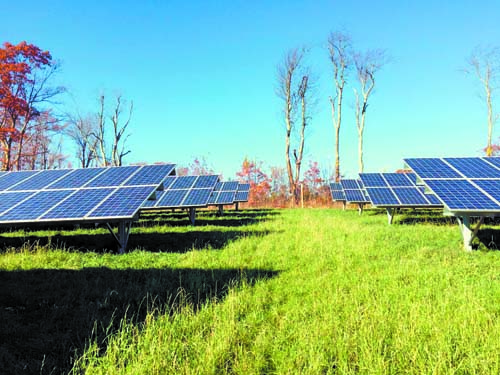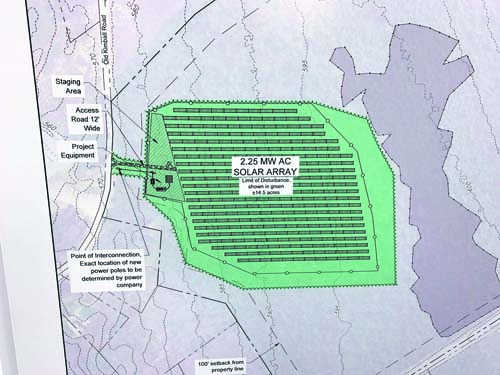Harrison planners approve solar projects

By Wayne E. Rivet
Staff Writer
HARRISON — When LD 1711 was signed into law, it was a “game changer” for the solar industry, according to Chris Byers of Boyle Associates, an environmental consultant.
The law opened the door to development of solar arrays, which had sprouted on farm land and other large tracts across the state.
The bill is designed to maximize benefits to both ratepayers and municipalities, in addition to make it easier to invest in solar, especially for commercial and municipal energy consumers.
Harrison will soon have two such solar farms — one off Old Kimball Road, the other off Norway Road.
Following an informal “open house,” which Byers and fellow Boyle associate Dale Knapp gave overviews of the projects and answered questions posed by abutters, Harrison planners gave unanimous approval to the two projects.
“The legislation made solar a viable market here,” Knapp said.
The Norway Road property, which is in tree growth, is owned by Davis and Anita Randall. The project will cover less than 20 acres.

“The design appropriately avoids and minimizes wetland impacts to the greatest extent practicable,” Byers wrote in the application. “While the lot size is 67 acres, only 14.5 acres of cleared area is required for the project footprint.”
The developer is Pine Gate with Boyle Associates serving as the environmental consultants.
The other site (a residential property) is at 40 Bolsters Mills Road, owned by Dale Frechette. The lease involves about 20 to 25 acres. The applicant was ISM Solar Development, LLC. CEO Greg Lucini, who lives on Thompson Lake in Oxford, is currently involved in six projects nearby (Gray, Naples, Oxford and Poland).
Panels are “tilted and fixed.” The two consultants noted that if technology changes and new panels are installed, the old ones likely would be sent to a secondary market (third world nations) because they remain useful.
The two Harrison locations were prime spots due to the contour of the land and proximity to three-phase power lines, which solar-produced energy can be channeled. Knapp, a principal and natural resource practice leader at Boyle Associates, noted that when property is leased for solar arrays, the agreement usually runs 20 to 25 years followed by renewals.
Land agents search out potential solar array sites and open discussions with property owners. Byers and Knapp determine if the site meets Site Plan criteria and is viable for the solar operation.
Questions posed at the open house included whether there would be a lot of noise from the inverters and transformer at the site. Knapp, who has been involved in solar projects for the past six to seven years, said solar arrays are “good neighbors” because little noise can be heard (“the equivalent of an air conditioner,” Byers said), especially since most sites possess a significant natural buffer between the solar farm and abutters. There are no lights.
Another question regarded clearing and maintenance. Byers noted that lots would be cleared of timber, and then seeded with mowing taking place twice a year. The projects should be up and running in 2020.
“You look to create the least environmental impact as possible, when looking at sites. You look for minimal disturbance, which reduces overall costs,” Knapp noted.
As for power generated, Byers said it stays here in Maine, as directed by LD 1711.
“We’ve generally received positive responses to these projects,” Knapp said. “Not only do we want to address concerns (one of the reasons I like the open house approach because it allows people to have one-on-one conversations or enable some people to stay at the edges, listen in and then ask a question), we also want to be informative.”
Byers said contact was made with Harrison Assistant Code Enforcement Officer Jim Fahey in August.
“Solar fits the bill for Mainers — it’s low visibility, low impact and a renewable energy source,” Byers added. “Energy is being added to the grid, which means better pricing for consumers.”
The two Harrison projects (although differing in size, about 8,000 panels) will produce enough power to service 600 homes.
Byers pointed out that due to electrical grid limitations, “you won’t see 30” solar projects in Harrison, but possibly four to five.

